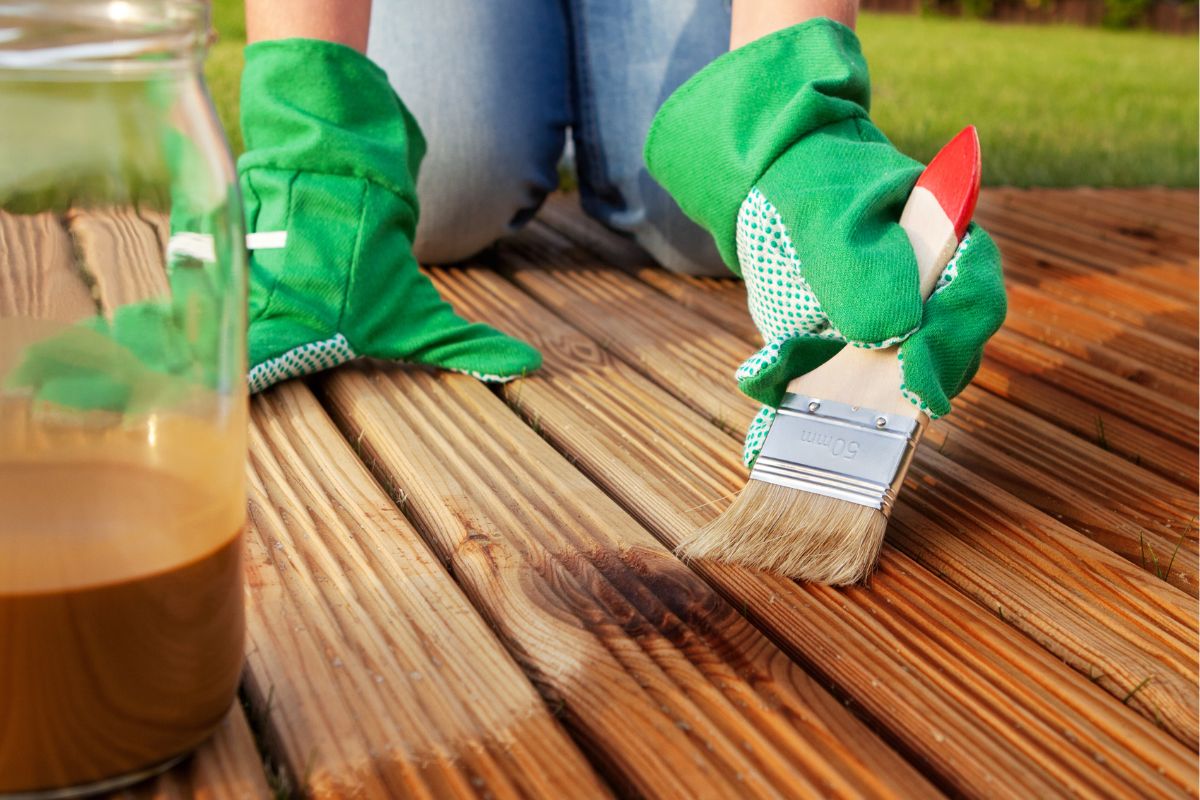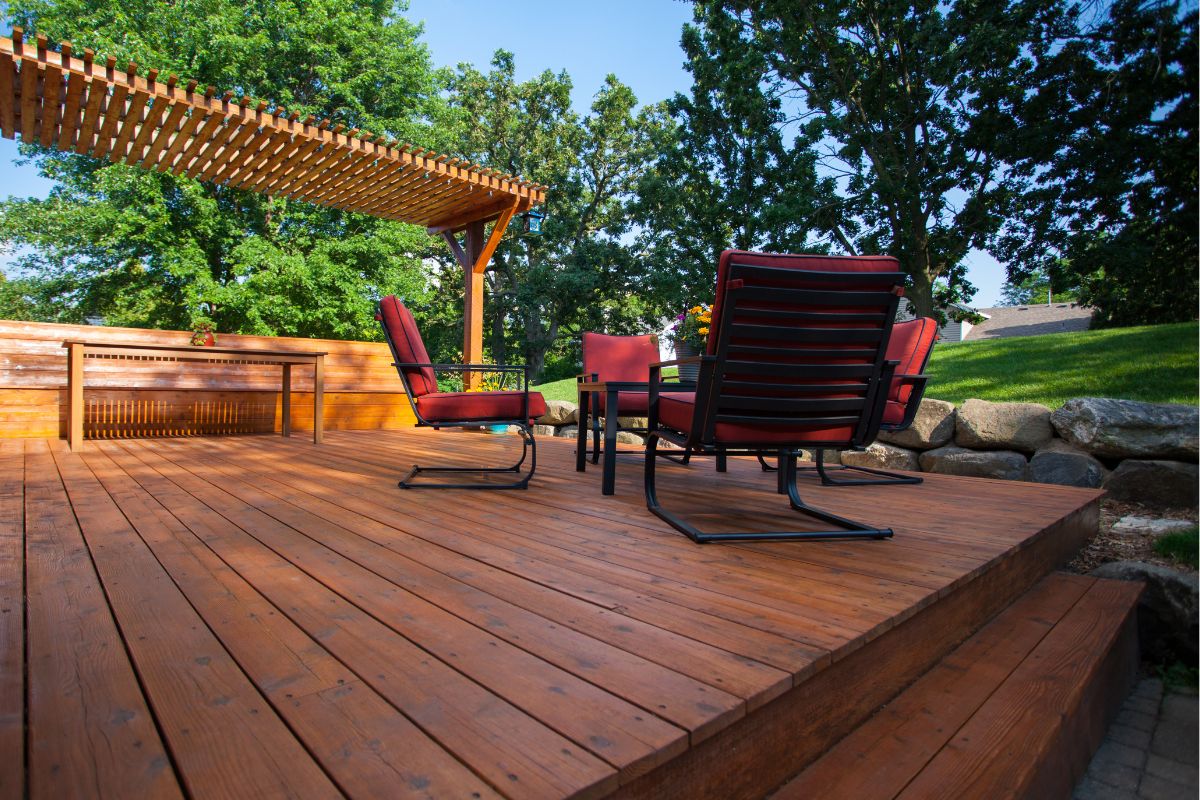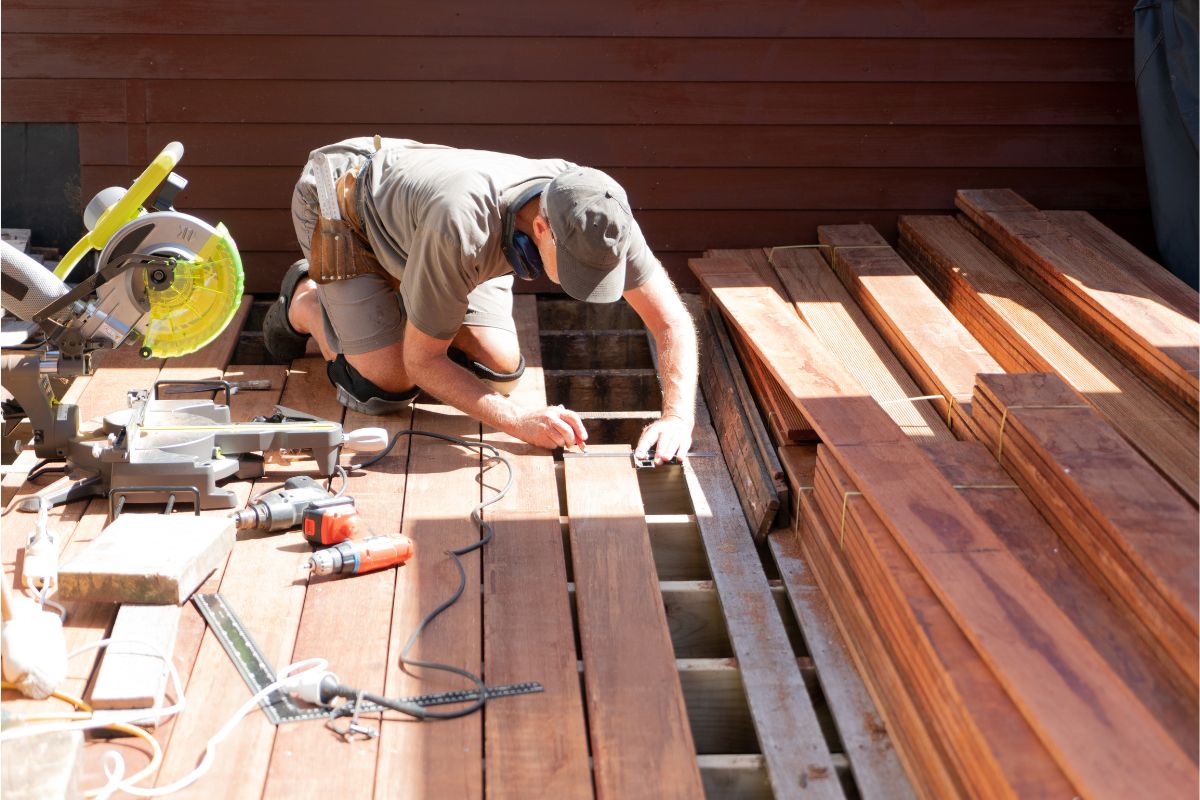Your deck is more than just an outdoor space—it’s where you gather with friends, relax with family, and enjoy the outdoors.
But to keep it looking great and staying safe, regular maintenance is key.
Here’s our recommended deck maintenance checklist to keep your deck in top shape. Going through this checklist can help prevent long-term damage like rot, warping, and loose boards, which can be costly to fix if left unchecked.
Transform your backyard with a beautifully designed deck by Perimeter Remodeling. From concept to construction, we specialize in creating custom decks that suit your style and needs.
Let us build the outdoor oasis you’ve been dreaming of, where you can entertain, unwind, and enjoy the seasons. Contact us today!
Clean Your Deck Regularly

Keeping your deck clean is the first step to prolonging its life. Routine cleaning prevents the buildup of dirt, mildew, and debris, which, if left unchecked, can lead to mold, rot, and surface wear.
How Often Should You Clean Your Deck?
The frequency of cleaning your deck largely depends on the material.
For wooden decks, it’s best to clean every 1-2 months, especially during the warmer seasons when dirt and pollen accumulate.
Composite decks more resistant to mold and staining can be cleaned less frequently—about every 3-4 months or as needed.
However, regardless of the material, it’s always a good idea to give your deck a thorough cleaning after heavy storms or prolonged exposure to moisture.
Step-by-Step Deck Cleaning Process
- Sweep Away Debris: Begin by sweeping the deck to remove loose dirt, leaves, and other debris. This will prevent scratching and make the cleaning process more effective.
- Wash the Deck with the Right Cleaner: Mix your eco-friendly deck cleaner according to the instructions, then use a scrub brush to gently clean the surface. Work in small sections, scrubbing with the grain of the wood or following the manufacturer’s recommendations for composite decks.
- Rinse and Dry Properly: After scrubbing, rinse the deck thoroughly with a hose or low-pressure washer. Allow the deck to air dry completely. Avoid using the deck until it’s fully dry to prevent moisture damage and slipping hazards.
Apply a Deck Sealant or Stain

Sealing and staining your deck are essential for shielding it from harsh weather conditions, such as rain, snow, and direct sunlight. These treatments act as a barrier against water absorption, which can lead to swelling, warping, and rot.
Staining also adds a layer of protection from UV rays that can fade and damage the wood over time.
How Often Should You Seal or Stain Your Deck?
The frequency of sealing or staining depends on factors like the type of wood, climate, and how often the deck is used.
For most wooden decks, sealing or staining every 1-3 years is recommended. Decks in harsher climates—those exposed to heavy rain, intense sunlight, or high humidity—may require more frequent treatment.
Hardwood decks, such as cedar or redwood, may need less frequent sealing compared to softwoods like pine. Always monitor your deck for signs of wear, such as fading or water soaking into the wood, as indicators that it’s time to reseal or restain.
Choosing the Right Sealant or Stain for Your Deck
Water-Based vs. Oil-Based Sealants
- Water-Based Sealants: These are eco-friendly and easier to clean up, drying faster than oil-based options. However, they may not penetrate as deeply into the wood, which might reduce their longevity.
- Oil-Based Sealants: Known for deeper penetration and longer-lasting protection, oil-based sealants provide excellent moisture resistance. However, they take longer to dry, can have a stronger odor, and may be more difficult to clean up.
Factors to Consider When Selecting a Stain
- UV Protection: Choose a stain with strong UV blockers to protect your deck from sun damage and fading.
- Color Options: Stains come in various shades, from transparent to semi-transparent to solid. The right choice depends on the look you want and how much of the wood’s natural grain you wish to showcase.
- Durability: Consider a stain’s durability, especially if your deck faces heavy foot traffic or extreme weather conditions. Solid stains tend to offer more durability but cover more of the wood’s natural beauty, while semi-transparent stains provide a balance between protection and aesthetics.
Step-by-Step Guide to Sealing or Staining Your Deck
Prepping the Surface
- Sanding: Start by sanding the deck to remove any rough spots, old stains, or sealants. This creates a smooth surface for the new treatment to adhere to.
- Cleaning: Thoroughly clean the deck to remove dust, dirt, and mildew. A deck cleaner or a mixture of soap and water will help lift grime from the surface.
- Let it Dry: Allow the deck to dry completely after cleaning. This step is crucial because applying stain or sealant to damp wood can trap moisture, leading to future damage.
Applying the Sealant or Stain
- Choose the Right Tools: Use a paintbrush, roller, or sprayer to apply the sealant or stain. Brushes are great for getting into crevices, while rollers and sprayers work well for covering large areas.
- Apply Evenly: Begin applying the sealant or stain evenly across the deck, working in small sections and following the wood grain for a consistent finish.
- Allow Adequate Drying Time: After application, give the sealant or stain sufficient time to dry. This can range from a few hours to a couple of days, depending on the product and weather conditions. Avoid using the deck until it’s completely dry to ensure the finish properly sets.
Conduct a Deck Inspection

Regular inspections not only help preserve your deck’s appearance but also prevent dangerous situations like unstable railings, loose boards, or hidden decay that could compromise its integrity.
What to Look for During a Deck Inspection
Check for Rot and Decay
Wooden decks are particularly vulnerable to rot, especially in areas exposed to constant moisture.
During your inspection, look for soft spots, discoloration, or signs of fungal growth, which indicate rot. Focus on areas where water might pool, like around posts, under stairs, or along the deck’s edge.
Inspect for Loose or Rusted Nails, Screws, and Fasteners
Over time, nails, screws, and other fasteners can loosen or rust, weakening the deck’s structure.
Check for any hardware that has come loose or is showing signs of rust. Tighten or replace fasteners as needed to maintain the deck’s stability and ensure everything is securely fastened.
Examine Railings and Stairs for Stability
Safety is a top priority when it comes to deck inspections. Give the railings a firm shake to check for any wobbling or instability.
Inspect stairs for any signs of weakening, such as sagging or loose steps. If any components feel unstable, repair or replace them immediately to prevent accidents.
Assess Deck Boards for Cracks or Splitting
Take a close look at the deck boards to identify any cracks, warping, or splitting. Damaged boards can deteriorate quickly, leading to more extensive repairs down the road.
Replace any boards showing significant wear before the damage spreads further.
How Often Should You Inspect Your Deck?
To keep your deck in optimal condition, plan to inspect it at least twice a year—typically in spring and fall.
It’s also essential to check your deck after harsh weather conditions like heavy rains, snow, or extreme heat, as these can accelerate wear and cause damage.
Regular inspections allow you to address minor issues promptly, preventing them from developing into larger, more expensive problems later on.
Repair Deck Damage

Timely repairs are crucial to maintaining the health and safety of your deck. Small issues like loose boards, cracks, or rusted nails can quickly escalate into more serious—and costly—problems if left unaddressed.
Common Deck Repairs You Can DIY
- Replacing Loose or Damaged Boards: If you notice any loose or damaged boards on your deck, it’s important to replace them promptly to prevent further deterioration.
- Tightening or Replacing Hardware: Loose screws, nails, or bolts can weaken the deck’s structure, posing safety risks.
- Patching Small Cracks or Holes: Small cracks or holes can be filled with wood filler or epoxy to prevent water from seeping in and causing rot.
When to Call a Professional for Deck Repairs
While many deck repairs are manageable with a DIY approach, certain issues require the expertise of a professional to ensure safety and longevity.
Recognizing when to seek professional deck installation services is crucial for addressing complex problems and preventing further damage.
Why Professional Help is Necessary
- Structural Integrity: Structural issues, such as sagging beams or unstable posts, can compromise the safety of your deck. These problems often require advanced knowledge and specialized equipment to properly address.
- Extensive Rot or Damage: Significant rotting or widespread damage can be challenging to repair effectively without professional experience. Professionals have the tools and techniques to manage extensive decay and restore the deck’s structural integrity.
- Complex Repairs: Certain repairs, like replacing multiple boards or reinforcing weak spots, may be more intricate and require professional skills to ensure a durable and safe outcome.
When to Call a Professional Deck Contractor
- Sagging or Drooping Beams: If you notice that your deck beams are sagging or drooping, this could indicate a serious structural problem that needs professional assessment and repair.
- Widespread Rot or Decay: Significant rotting affecting large sections of the deck requires expert evaluation and treatment to prevent further deterioration and maintain safety.
- Loose or Unstable Posts: If the support posts or foundation of your deck are loose or unstable, a professional can properly secure or replace them to ensure the deck’s stability.
- Multiple Board Replacements: Replacing several damaged boards, especially if they span different sections, often requires precise fitting and alignment that professionals can handle more efficiently.
- Complex Reinforcements: If your deck has weak spots or requires structural reinforcements, professionals can provide the necessary support and expertise to address these issues effectively.
Seasonal Deck Maintenance Checklist

We’ve covered some essential general maintenance tasks to keep your deck in top shape, such as regular cleaning, sealing, and inspections.
However, maintaining your deck is an ongoing process that varies with the seasons. Each time of year brings its own set of challenges and tasks to ensure your deck stays safe, functional, and beautiful.
To help you stay on top of your deck care, here’s a seasonal breakdown of what to focus on throughout the year:
Spring Deck Maintenance
Spring is the ideal time to assess the state of your deck after the winter months. Start the season by:
- Cleaning the Deck: Remove all debris such as leaves, twigs, and dirt. Use a broom or leaf blower, followed by a thorough washing with a deck cleaner suitable for your deck material.
- Inspecting for Winter Damage: Check for signs of damage caused by snow and ice, such as cracked or warped boards, loose nails or screws, and any potential rot or mildew.
- Repairing Any Damage: Address any issues identified during your inspection. Replace damaged boards, tighten loose hardware, and treat any signs of rot or mold.
Summer Deck Maintenance
During the summer months, your deck likely experiences heavy use. To keep your deck cool in summer and maintain its condition, follow these tips:
- Applying a Fresh Coat of Stain or Sealant: If it’s been a couple of years since your last application, summer is a good time to reapply stain or sealant to protect against sun damage and moisture. Choose a sunny day for application to ensure proper drying.
- Regular Cleaning: Keep up with routine cleaning to remove dust, spills, and grime. This prevents the buildup of dirt that can lead to wear and tear over time.
- Checking for Sun Damage: Inspect for signs of fading or weathering. Regularly sweeping and cleaning can help minimize sun damage, but if you notice significant fading, consider applying a UV-protectant treatment.
Fall Deck Maintenance
As the weather cools down, prepare your deck for the winter season by:
- Cleaning Thoroughly: Remove fallen leaves, branches, and other debris that can trap moisture and lead to mold or rot. Ensure the deck is dry before the cold sets in.
- Sealing the Deck: Apply a fresh coat of sealant if it’s been a while since the last application. This helps protect the wood from winter moisture and freeze-thaw cycles.
- Covering Furniture: Protect deck furniture from the elements by covering it or storing it indoors. This prevents damage from falling leaves, rain, or early snow.
Winter Deck Maintenance
Winter can be tough on your deck, so regular maintenance is crucial:
- Removing Snow and Ice Safely: Use a plastic shovel or broom to gently remove snow and ice. Avoid using metal shovels or salt, which can damage the deck’s surface. For icy conditions, consider using sand or a de-icing product safe for wood.
- Checking for Moisture Buildup: Periodically inspect your deck for signs of moisture accumulation, especially in areas where snow may pile up. Look for any potential leaks or areas where water might be trapped and could cause damage when temperatures drop.
- Inspecting for Damage: During breaks in winter weather, check for any signs of damage or wear, such as loose boards or potential rot. Addressing these issues early can prevent more significant problems as the weather warms up.
Keep Your Deck in Top Shape with Expert Help
Regular maintenance is the key to extending the life of your deck and ensuring it remains a safe and beautiful space for years to come.
While many of the deck maintenance tasks outlined can be tackled on your own, there are times when professional expertise is essential—especially for more complex repairs or extensive damage. When in doubt, it’s always best to seek help from experts who can ensure your deck is properly cared for and maintained.
Inspired to give your deck the attention it deserves? Our team at Perimeter Remodeling is here to help. With years of experience in deck inspections, repairs, and maintenance, we’re dedicated to keeping your outdoor space in top condition.
Explore our remodeling services and see how we can transform your deck into the perfect place for relaxation and enjoyment.
Contact us today for a free consultation and let’s get started on maintaining or enhancing your deck to its fullest potential!



Recent Comments